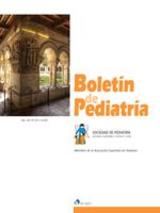Percepción de los pediatras de Atención Primaria de su relación con la Pediatría Hospitalaria
S. Alberola López , I. Casares Alonso , J.F. Colinas Herrero , M. Garrido Redondo , F.J. Pellegrini Belinchón , I. Pérez García
Bol. Pediatr. 2021; 61 (257): 147 - 153
Objetivo. El objetivo de este trabajo es conocer la percepción que tienen los pediatras de Atención Primaria (PAP) de Castilla y León de su relación con la Pediatría Hospitalaria. Población y métodos. Se realizó una encuesta entre los pediatras de Atención Primaria para conocer la relación entre niveles asistenciales en las 11 áreas sanitarias de la Comunidad. El cuestionario es anónimo y consta de 16 preguntas en dos bloques: 9 sobre “cómo es/cómo percibimos la relación entre los PAP y el hospital” (bloque 1) y 7 sobre “qué cosas son importantes para los PAP/qué se pide al hospital” (bloque 2). Se puntúa con una escala Likert de 1 (nada) a 5 (máximo). Resultados. Respondieron 134 pediatras (84% mujeres). El 64% tiene 15 años de experiencia en PAP. El 77% trabajan como pediatras de equipo, y el 64% en centros urbanos. El 43% tiene cupos de 800-999 pacientes. El 24% son tutores de apoyo MIR y el 24% colabora en la formación de estudiantes de Medicina. En el primer bloque de preguntas se observan medianas entre 2 y 4 de puntuación Likert, y en el segundo bloque los valores son más elevados (mediana 4). Encontramos diferencias significativas al comparar las respuestas por áreas sanitarias, en todas las preguntas del primer bloque y en la mayoría del segundo. Conclusión. La relación entre niveles es aceptable en su conjunto, con importantes diferencias entre áreas sanitarias.
Perception of the Primary Care pediatricians of their relationship with Hospital Pediatrics
Objective. To know the perception that Primary Care pediatricians (PCP) of Castilla y Leon have about their relationship with hospital pediatricians.
Population and methods. A survey was conducted among PCP to find out the relationship between healthcare levels in the 11 health areas of the Community. The questionnaire is anonymous and consists of 16 questions (two blocks): 9 about “how is/how we perceive the relationship between the PCP and the hospital” (first block) and 7 about “what is important for the PCP/what is asked to the hospital” (second block). It is scored on a Likert scale from 1 (not at all) to 5 (maximum).
Results. 134 pediatricians answer (84% women). 64% have 15 years of experience as PCP. 77% work as team pediatrician, and 64% in urban settings. 43% attends 800-999 patients. 24% are support tutors and 24% are trainers of medical students. Medians between 2 and 4 of Likert scores are observed in the first block of questions, and values are higher (4) in the second one. We find significant differences when making comparisons by Health Areas in all the questions in the first block and in most of them in the second.
Conclusión. The relationship between healthcare levels is acceptable as a whole with important differences among health areas
Artículo completo (PDF) (101 kb.)
- Otros
Buscar en el boletín
Año 2021, Volumen 61, Número 257

Boletín completo en PDF (847 kb.)